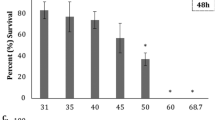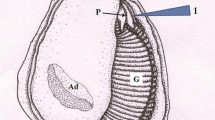Abstract
At reduced salinities, brooding females of some gastropods and bivalves may isolate their mantle cavities from the environment for several days, maintaining internal osmotic concentration but causing severe declines in dissolved oxygen and pH, and increases in ammonia and other toxic substances in the mantle fluid. This study in November–December examined the immediate consequences of such stresses for brooded embryos of Quempillén estuary gastropod Crepipatella dilatata, in terms of time to juvenile emergence and rates of embryonic growth [measured as shell length (SL)]. Juveniles were also monitored for latent effects on feeding rates, oxygen consumption, and growth for the first 4 weeks after emergence into normal salinity seawater. An acute salinity stress lasting 3 days applied to females that were brooding pre-shelled or intermediate-shelled stages increased embryonic incubation periods, but without affecting SL at emergence. Growth rates were reduced for encapsulated embryos regardless of the stage at which the salinity stress was applied. Latent effects on juvenile development included slower shell growth and reduced rates of oxygen consumption and feeding. These effects were sustained for the first month after release from the female. The results suggest that marked reductions in salinity lasting for several days indirectly but negatively affect the development of brooded embryos of C. dilatata and also affect the juveniles for at least several weeks following their release, even after salinity has returned to normal.







Similar content being viewed by others
References
Bennett CE, Marshall DJ (2005) The relative energetic costs of the larval period, larval swimming and metamorphosis for the ascidian Diplosoma listerianum. Mar Freshw Behav Physiol 38:21–29
Chaparro OR, Paschke KA (1990) Nurse egg feeding and energy balance in embryos of Crepidula dilatata (Gastropoda: Calyptraeidae) during intracapsular development. Mar Ecol Prog Ser 65:183–191
Chaparro OR, Bahamondes-Rojas I, Vergara AM, Rivera AA (1998) Histological characteristics of the foot and locomotory activity of Crepidula dilatata Lamarck (Gastropoda: Calyptraeidae) in relation to sex changes. J Exp Mar Biol Ecol 223:77–91
Chaparro OR, Oyarzun RF, Vergara AM, Thompson RJ (1999) Energy investment in nurse eggs and egg capsules in Crepidula dilatata Lamarck (Gastropoda, Calyptraeidae) and its influence on the hatching size of the juvenile. J Exp Mar Biol Ecol 232:261–274
Chaparro OR, Montiel YA, Cubillos VM (2005) Direct intracapsular development: implications for feeding mechanisms in early juveniles of the gastropod Crepidula dilatata. J Mar Biol Assoc UK 85:163–169
Chaparro OR, Cubillos VM, Montiel YA, Paschke KA, Pechenik JA (2008a) Embryonic encapsulation and maternal incubation: requirements for survival of the early stages of the estuarine gastropod Crepipatella dilatata. J Exp Mar Biol Ecol 365:38–45
Chaparro OR, Montiel YA, Segura CJ, Cubillos VM, Thompson RJ, Navarro JM (2008b) The effect of salinity on clearance rate in the suspension-feeding estuarine gastropod Crepipatella dilatata under natural and controlled conditions. Estuar Coast Shelf Sci 76:861–868
Chaparro OR, Segura CJ, Montiel YA, Thompson RJ, Navarro JM (2008c) Variations in the quantity and composition of seston from an estuary in southern Chile on different temporal scales. Estuar Coast Shelf Sci 76:845–860
Chaparro OR, Segura CJ, Montory JA, Navarro JM, Pechenik JA (2009a) Brood chamber isolation during salinity stress in two estuarine mollusk species: from a protective nursery to a dangerous prison. Mar Ecol Prog Ser 374:145–155
Chaparro OR, Montory JA, Segura CJ, Pechenik JA (2009b) Effect of reduced pH on shells of brooded veligers in the estuarine bivalve Ostrea chilensis Philippi 1845. J Exp Mar Biol Ecol 377:107–112
Chaparro OR, Montory JA, Pechenik JA, Cubillos VM, Navarro JM, Osores SJ (2011) Ammonia accumulation in the brood chamber of the estuarine gastropod Crepipatella dilatata: how big a problem for mothers and brooded embryos? J Exp Mar Biol Ecol 410:29–38
Chaparro OR, Lincoqueo LA, Schmidt AJ, Veliz D, Pechenik JA (2012) Comparing biochemical changes and energetic costs in gastropods with different developmental modes: Crepipatella dilatata and C. fecunda. Mar Biol 159:45–56
Chiu JMY, Wang H, Thiyagarajan V, Qian PY (2008) Differential timing of larval starvation effects on filtration rate and growth in juvenile Crepidula onyx. Mar Biol 154:91–98
Coughlan J (1969) The estimation of filtering rate from the clearance of suspensions. Mar Biol 2:356–358
Djangmah JS, Shumway SE, Davenport J (1979) Effects of fluctuating salinity on the behaviour of the West African blood clam Anadara senilis and on the osmotic pressure and ionic concentrations of the haemolymph. Mar Biol 50:209–213
Fretter V (1984) Prosobranchs. In: Tompa AS, Verdink NH, van den Biggelaar JAM (eds) The Mollusca, Vol 7, Reproduction. Academic Press, Inc., Orlando, FL
Gallardo CS (1979) Especies gemelas del género Crepidula (Gastropoda, Calyptraeidae) en la costa de Chile; una redescripción de C. dilatata Lamarck y descripción de C. fecunda n.sp. Stud Neotrop Fauna Environ 14:215–226
Gebauer P, Paschke K, Anger K (2003) Delayed metamorphosis in decapod crustaceans: evidence and consequences. Rev Chil Hist Nat 76:169–175
Gillespie JM, McClintock JB (2007) Brooding in echinoderms: how can modern experimental techniques add to our historical perspective? J Exp Mar Biol Ecol 342:191–201
Glantz SA (2011) Primer of biostatistics, 7th edn. McGraw-Hill Medical, New York, p 320
Gosselin LA, Qian P-Y (1997) Juvenile mortality in benthic marine invertebrates. Mar Ecol Prog Ser 146:265–282
Hunt HL, Scheibling RE (1997) Role of early post-settlement mortality in recruitment of benthic marine invertebrates. Mar Ecol Prog Ser 155:269–301
Li A, Chiu JMY (2013) Latent effects of hypoxia on the gastropod Crepidula onyx. Mar Ecol Prog Ser 480:145–154
Monteiro NM, Almada VC, Vieira MN (2005) Implications of different brood pouch structures in syngnathid reproduction. J Mar Biol Assoc UK 85:1235–1241
Montiel YA, Chaparro OR, Segura CJ (2005) Changes in feeding mechanisms during early ontogeny in juveniles of Crepidula fecunda (Gastropoda, Calyptraeidae). Mar Biol 147:1333–1342
Montory JA, Chaparro OR, Cubillos VM, Pechenik JA (2009) Isolation of incubation chambers during brooding: effect of reduced pH on protoconch development in the estuarine gastropod Crepipatella dilatata (Calyptraeidae). Mar Ecol Prog Ser 374:157–166
Moran AL (2000) Calcein as a marker in experimental studies of newly-hatched gastropods. Biol Mar 137:893–898
Nasrolahi A, Pansch C, Lenz M, Wahl M (2012) Being young in a changing world: how temperature and salinity changes interactively modify the performance of larval stages of the barnacle Amphibalanus improvisus. Mar Biol 159:331–340
Pechenik J (2006) Larval experience and latent effects: metamorphosis is not a new beginning. Integr Comp Biol 46:323–333
Pechenik JA, Rice M (2001) Influence of delayed metamorphosis on post-settlement survival and growth in the sipunculan Apionsoma misakianum. Invertebr Biol 120:50–57
Pechenik JA, Estrella MS, Hammer K (1996) Food limitation stimulates metamorphosis of competent larvae and alters postmetamorphic growth rate in the marine prosobranch gastropod Crepidula fornicata. Mar Biol 127:267–275
Pechenik JA, Gleason T, Daniels D, Champlin D (2001) Influence of larval exposure to salinity and cadmium stress on juvenile performance of two marine invertebrates Capitella sp. I and Crepidula fornicata. J Exp Mar Biol Ecol 264:101–114
Pechenik JA, Jarrett JN, Rooney J (2002) Relationships between larval nutritional experience, larval growth rates, juvenile growth rates, and juvenile feeding rates in the prosobranch gastropod Crepidula fornicata. J Exp Mar Biol Ecol 280:63–78
Phillips NE (2002) Effects of nutrition-mediated larval condition on juvenile performance in a marine mussel. Ecology 83:2562–2574
Phillips NE (2004) Variable timing of larval food has consequences for early juvenile performance in a marine mussel. Ecology 85:2341–2346
Qiu JW, Qian PY (1999) Tolerance of the barnacle Balanus amphitrite amphitrite to salinity and temperature stress: effects of previous experience. Mar Ecol Prog Ser 188:123–132
Satuito CG, Shimizu K, Natoyama K, Yamazaki M, Fusetani N (1996) Age-related settlement success by cyprids of the barnacle Balanus amphitrite, with special reference to consumption of cyprid storage protein. Mar Biol 127:125–130
Segura CJ, Chaparro OR, Paschke KA, Pechenick JA (2010) Capsule walls as barriers to oxygen availability: implications for the development of brooded embryos by the estuarine gastropod Crepipatella dilatata (Calyptraeidae). J Exp Mar Biol Ecol 390:49–57
Shumway SE (1977) The effect of fluctuating salinity on the tissue water content of eight species of bivalve molluscs. J Comp Physiol 116:269–285
Thébault J, Chauvaud L, Clavier J, Fichez R, Morize E (2006) Evidence of a 2-day periodicity of striae formation in the tropical scallop Comptopallium radula using calcein marking. Mar Biol 149:257–267
Thiyagarajan V, Pechenik J, Gosselin LA, Qian PY (2007) Juvenile growth in barnacles: combined effects of delayed metamorphosis and sub-lethal exposure of cyprids to low-salinity stress. Mar Ecol Prog Ser 344:173–184
Toro JE, Winter JE (1983) Estudios en la ostricultura Quempillén, un estuario del sur de Chile. Parte I. La determinación de los factores abióticos y la cuantificación del seston como oferta alimenticia y su utilización por Ostrea chilensis. Mems Asoc Latinoam Acuicult 5:129–144
Acknowledgments
All experiments were conducted at Calfuco Coastal Laboratory and the Quempillén Estuarine Station, and we thank all at those laboratories who assisted in this work. The research was funded by Fondecyt (Fondo Nacional de Investigación Científica y Tecnológica—Chile) Grant No. 1100335.
Author information
Authors and Affiliations
Corresponding author
Additional information
Communicated by J. Grassle.
Rights and permissions
About this article
Cite this article
Chaparro, O.R., Segura, C.J., Osores, S.J.A. et al. Consequences of maternal isolation from salinity stress for brooded embryos and future juveniles in the estuarine direct-developing gastropod Crepipatella dilatata . Mar Biol 161, 619–629 (2014). https://doi.org/10.1007/s00227-013-2364-8
Received:
Accepted:
Published:
Issue Date:
DOI: https://doi.org/10.1007/s00227-013-2364-8




